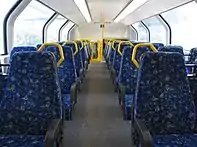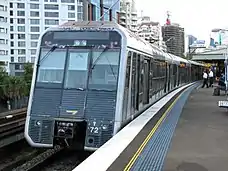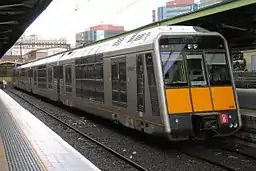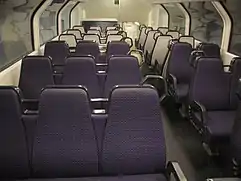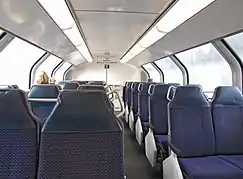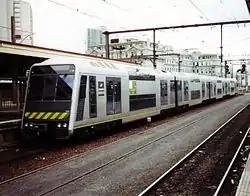Sydney Trains T set
The T sets, also referred to as the Tangara trains (an Aboriginal Australian word meaning to go) is a class of electric multiple unit operated by Sydney Trains in Sydney, Australia. The Tangaras were delivered between 1988 and 1995, and are third-generation trains.[1]
| T set | |
|---|---|
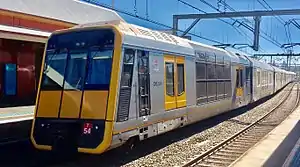 T54 in Sydney Trains livery | |
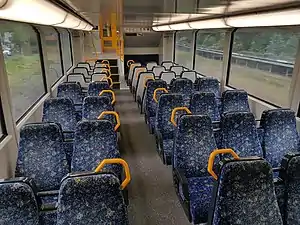 Interior | |
| In service | 1988-present |
| Manufacturer | Goninan |
| Built at | Broadmeadow |
| Constructed | 1987–1995 |
| Entered service | 1988 |
| Refurbished | 2003, 2010, 2014, 2019 |
| Number built | 455 carriages |
| Number in service | 447 carriages |
| Number scrapped | 8 carriages |
| Formation | 4 car sets |
| Capacity | 98 in driving trailers, 112 in motor cars |
| Operator(s) | Sydney Trains |
| Depot(s) | Hornsby Mortdale |
| Line(s) served | T1 North Shore & Western T4 Eastern Suburbs & Illawarra T7 Olympic Park (special events only) T9 Northern South Coast Line (between Waterfall and Port Kembla) |
| Specifications | |
| Car length | 20.32 m (66 ft 8 in) |
| Width | 3,000 mm (9 ft 10 1⁄8 in) 3,168 mm (10 ft 4 3⁄4 in) with doors open on both sides |
| Height | 4,413 mm (14 ft 5 3⁄4 in) |
| Weight | 50.1 t (49.3 long tons; 55.2 short tons) (N Car) 42.3 t (41.6 long tons; 46.6 short tons) (D Car) (former G set cars are heavier) |
| Traction system | 4-quadrant GTO Chopper Control (Mitsubishi Electric) |
| Power output | 4 x 170 kW (230 hp) |
| Power supply | (?) |
| Electric system(s) | 1500 V DC Catenary |
| Current collection method | Pantograph |
| Track gauge | 1,435 mm (4 ft 8 1⁄2 in) standard gauge |
Current design
A Tangara is a double-deck four-car set, with the two outer cars being driving control trailers (carrying a D prefix) fitted with one pantograph each and the middle two cars being non-control motor cars (carrying a N prefix). They are equipped with air conditioning and chopper control.
Two subclasses of Tangara were built, the suburban sets targeted as T sets, and outer-suburban sets originally targeted as G sets. The T sets replaced the first generation of Sydney's electric rolling stock.[1] The G sets were converted to suburban use and were re-targeted as additional T sets.
Unlike most other Sydney Trains rolling stock, the seats on the suburban T sets are fixed, meaning that half the seats face backwards.
The G sets differed from the T sets in originally having round green door buttons, high-backed reversible seats, toilets, fresh water dispensers and luggage racks. Additionally, the G sets were delivered with a revised design at the front and rear of the train, most notably the pinstriped grey panels below the cab windows were replaced with light orange panels for improved visibility.
Set G7 was fitted with an AC drive system for evaluation purposes with the existing DC stock and compatibility with signalling and communication systems on the network. G7 was scrapped in 2005 at Maintrain, Auburn after the Waterfall train disaster, as all four cars were beyond repair.
History
When first introduced, the T sets were fitted with passenger door release handles to prevent loss of air conditioning at stations. These were later disconnected (and later removed) due to passengers not getting used to opening the doors for themselves when needed. The seats originally had fabric upholstery, but this was gradually replaced by blue vinyl.
In the early 2000s, all Tangaras were updated with a new CityRail corporate appearance. This involved painting the passenger doors and much of the front and rear ends of the trains yellow. Blue and yellow stripes along the bottom of the carriages were replaced by a single yellow stripe and updated CityRail logos were placed on the driving cars.
Initial delivery

In July 1986, the Government of New South Wales awarded A Goninan & Co a contract for 450 carriages.[2] In 1993 it was decided that the last 80 carriages of the order would be built to a modified design to operate peak-hour services to Wyong, Port Kembla and Dapto.[3] In 1996 five spare driving trailers were ordered.[4]
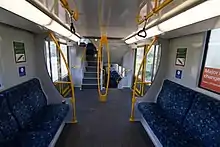
The first train (set T20) was unveiled at Sydney Central in December 1987, heavily promoted as the “train of the 21st century”,[5] entering service in April 1988. The final T set (set T59) was delivered in February 1994 and the final G set (set T100, formerly G32) in October 1995.[6]
The cars built were:
- T set driving trailer cars: D6101-D6284 with additional spare cars D6285-D6289
- T set non-driving motor cars: N5101-N5284 with additional spare car N5285
- G set driving trailer cars: OD6801-OD6840 with additional spare car OD6841
- G set non-driving motor cars: ON5801-ON5820
- G set non-driving motor cars with toilet: ONL5851-ONL5870
Conversion of G sets to T sets
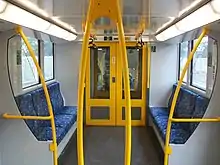
In late 2005, 15 V set carriages were suddenly withdrawn due to the discovery of corrosion in their underframes. G sets began to operate more off-peak Intercity services to Port Kembla, Kiama, and Wyong to cover for the withdrawn V sets. H sets started entering service in December 2006. The newer trains feature a very similar level of passenger amenity to the G sets and can be seen as a continuation of the design. Their introduction lead to a change in the role of the G sets. From 2007, the G sets were progressively redeployed to suburban services, providing extra capacity on high-demand existing services such as on the Western line and allowing new services to be introduced. By 2008, G sets were often used on peak suburban services that extended into intercity areas, such as services to Springwood (via the Western line).
In 2009, the conversion of G sets to T sets began, to improve their suitability for suburban working as H sets took over their outer suburban duties. Conversion work consisted of the removal of toilets and their replacement with additional seating. Other work included the installation of new handrails and hangers and the recoding of cars and sets. The carriage numbers were kept, however the O (outer suburban) prefix was dropped. OD became D, while ONL and ON became N. The set numbers were changed from G1-30 to T100-130. G4 was the first to be converted (into T104). In 2010, sets being converted started receiving a full interior refurbishment as part of the program to refurbish all the Tangara carriages. In 2018, sets T14 and T121 (ex G21) both became mixtures of T set and ex-G set carriages, with both sets swapping two carriages with each other.
Upgrades in the 2010s
In 2010, a refresh of the Tangaras commenced with the interiors repainted, and new seating upholstery and handrails fitted.[7][8]
In July 2013, Sydney Trains trialled rearranging the seating on the upper and lower decks of two carriages. There were 16 fewer seats per carriage; 3x2 seats were replaced by 2x2 seats in one carriage (N5134 on set T78) while in the other carriage (N5131 on set T77) there are double seats on one side and a bench style seating on the other. Both carriages were later returned to the normal 3x2 arrangement.[9]
In 2014, phase one of a technology upgrade program, aiming to improve reliability and upgrade ageing components, was underway.[10] A contract for phase two of the program, aiming to extend the life of these trains and bring technology into line with newer trains was awarded to UGL Limited in August 2015. This was expected to be completed by July 2018.[11][12] The expected completion date has been revised to 2019.[13]
The first phase of the program involved upgrading the passenger doors to cut down on vandalism, as the steel panels on the original doors were prone to being kicked out by vandals. The door kicking incidents often led to unnecessary delays as the guard had to lock off the affected carriage. The new lightweight passenger doors have a similar design to the doors on the Millennium M sets, namely the window shape with the curved bottom. This phase of the project was completed at the end of July 2016. The first set to receive the new doors was T96, in October 2014.
The program includes overhauling air conditioning units and windscreen wiper units, replacing passenger side doors, train operating systems and driver's desks.[10]
Other anti-vandal improvements included the introduction of 'Mousetrap' sensors. Trialed in 2015, these sensors are able to detect vapors from strong permanent markers and spray paint; triggering an in-built camera feed which is relayed to Sydney Trains staff as well as the Police Transport Command.[14]
Service
Damaged carriages
The following Tangara carriages have been scrapped due to accidents:
- Driving Trailer Cars: D6114, D6127, D6274, OD6831 & OD6832
- Motor Cars: N5127, ON5816 & ONL5866
The following are replacement carriages:
- D6285 & N5285 are on set T19 (replacing written-off cars D6127 & N5127)
- D6286 is on set T99 (replacing written-off D6274)
- D6287 is on set T73 (replacing written-off D6114)
- D6108 is on set T16 (replacing D6241 which has been stripped for spare parts)
- D6288 is on set T71 (replacing D6108 which is replacing D6241)
- D6289 is on set T24 (replacing D6148 which replaced D6106 on set T1, until D6106 returned to T1)
- D6184 is on set T37 (repaired set back to normal)
- D6841 is on set T103 (replacing D6823)
- D6252 is on set T13 (replacing D6249)
- D6807, N5252 & D6148 are on set T121 (replacing D6841, N5854 & D6808)
- D6808 & N5854 are on set T14 (replacing D6252 & N5252)
- Ex-G Set car D6841 has previously filled in for D6811, D6174, D6208, and then D6807 as a spare car over the years.
- D6807 also filled in for D6273 on T99 in January 2001 as a spare car before D6273 was returned to T99.
Driving trailer car D6127 and motor car N5127 were both involved in the Wentworthville train derailment on 27 December 1989, the first major accident involving the Tangara fleet. D6127 was written off, having collided with the platform. N5127 was sent to Dunheved on the Ropes Creek line for training fire fighters, along with S Set car C3866.[15]
Lines serviced
The Tangaras usually operate on the following lines:
- T1 North Shore & Western Line: Emu Plains to City via Parramatta, City to Berowra or Hornsby via Gordon
- T4 Eastern Suburbs & Illawarra Line: Bondi Junction to Waterfall & Cronulla via Hurstville & Sutherland
- T7 Olympic Park Line: Lidcombe to Olympic Park
- T9 Northern Line: Gordon to Hornsby via Strathfield
- South Coast Line: Waterfall & Thirroul to Port Kembla
Since 2013, their operation on Sector 2 has ended timetable services with all of them being displaced to Sector 1 since A sets do not operate on that sector.
Occasionally, as required, they will operate on other suburban lines, as all drivers are trained for Tangaras.
Tangara Technology Upgrade Phase 2
In May 2019, Tangara sets T106 (Ex G6) and T72 were released for testing the new technology upgrades, which include internal information screens, external destination boards and new voice announcements, both automated and digital. As the program is running late, four 4-car sets have been removed from service to accelerate the program, which requires one 8-car T set roster on Sector 3 to be operated by an extra Waratah A set. The project was due for completion by the end of 2020, however, this target will not be met, since none of the upgraded Tangaras are in service as of 9 September 2020.
The full list of features added to the Tangara trains is as follows:
- - New LCD passenger information displays and digital voice announcements
- - Fold-up vestibule seating for customers in wheelchairs
- - Upgraded lighting
- - New external destination boards
- - Security cameras (in a similar location to the Waratah trains)
- - Push button-operated gangway doors between carriages
- - Small hole above the doors covered
- - New gangways
- - Red courtesy seats
- - More railings (The small padded lower backrest has been removed)
- - New pantographs
- - New air conditioning
- - New driver and guard controls
- - New emergency help points
- - Automatic Train Protection (ATP)
Incidents
Carriage pierced by guard rail
During evening peak on 15 January 2014, motor car N5222 on set T10 was pierced by a guard rail near Edgecliff railway station while on a service to Cronulla. Issues with the train were already developing on the previous run, triggering wheelslip sensors on the train multiple times. As the train entered the Eastern Suburbs Line, a strong burning smell was reported at several stations. It was later revealed that an incorrectly repaired axle on N5222 led to the force of the 440-tonne train picking up the piece of guard rail. [16]
Loose roof hatch
Just after 5 AM on 23 August 2019, set T50 blocked a critical line near Town Hall station due to a loose roof hatch on driving trailer car D6223, believed to have been damaged by a falling tree branch the night before. The roof hatch was dangerously close to the overhead electrical lines, and so power had to be isolated before moving it. This led to serious delays throughout the entire train network that disrupted both the morning and evening peak. Roads throughout Sydney were also blocked due to not coping with replacement buses. [17]
4D
A train bearing strong resemblance to a Tangara, known as the 4D, was built by A Goninan & Co in 1991 for the Public Transport Corporation.[18] Although outwardly similar to the Tangaras it was mechanically very different being built to be compatible with the Comeng trains operated in Melbourne. It was included in the sale of Hillside Trains to Connex Melbourne in August 1999. It wasn't successful and after spending large periods out of service, being withdrawn in December 2002 and stored at Newport Workshops. The 4D was bought by CityRail for parts and then scrapped in March 2006 by them at Sims Metal, Brooklyn Victoria. The G sets' cab ends have a design similar to the 4D, with the bottom part being bent inwards.
References
- "Generations of electric rolling stock". www.transport.nsw.gov.au. Transport for NSW. 12 December 2017. Retrieved 21 April 2019.
- "Tangara Contract" Railway Digest September 1986 page 273
- "A Goninan & Co" Railway Digest October 1993 page 417
- "A Review of Electric Multiple Unit rolling stock" Railway Digest September 1996 page 32
- "Tangara Preview" Railway Digest February 1988 page 49
- "450th Tangara Delivered" Railway Digest December 1995 page 6
- Major makeover for Tangara fleet NSW Government 30 April 2010
- Tangara fleet to get make-over CityRail Xpress edition 127 28 April 2010
- "All change as RailCorp is disbanded" Sydney Morning Herald 1 July 2013
- "Transport for NSW 2013-14 Annual Report" (PDF). Transport for NSW. p. 28. Retrieved 13 February 2018.
- UGL awarded $131m contract for Tangara technology upgrade UGL Limited 5 August 2015
- Newcastle train builder awarded $131m contract ABC News 5 August 2015
- "Fleet update - September 2017" (PDF). Transport for NSW. September 2017. p. 4. Archived from the original (PDF) on 13 February 2018. Retrieved 12 February 2018.
- Saulwick, Jacob (7 May 2015). "'Mousetrap': Sydney trains sniff out graffiti vandals with new technology". The Sydney Morning Herald. Retrieved 12 October 2020.
- "A Review of Electric Multiple Unit Rolling Stock" Railway Digest September 1994 page 32
- Derailment of Sydney Trains Passenger Train 602M near Edgecliff station, Sydney, NSW on 15 January 2014 Australian Transport Safety Bureau
- Sydney commuters warned over more train delays SBS 23 August 2019
- Double Deck Development and Demonstration (4D) Train Vicsig
Further reading
- Beckhaus, John; Halgren, Stephen (2007), Sydney's Electric Trains, Australian Railway Historical Society NSW Division, ISBN 978-0-9757870-8-3
External links
![]() Media related to New South Wales T & G sets at Wikimedia Commons
Media related to New South Wales T & G sets at Wikimedia Commons
- T set technical diagrams Transport for NSW
- G set technical diagrams
